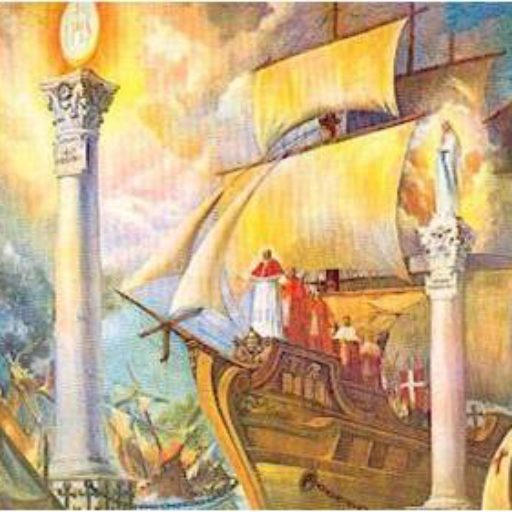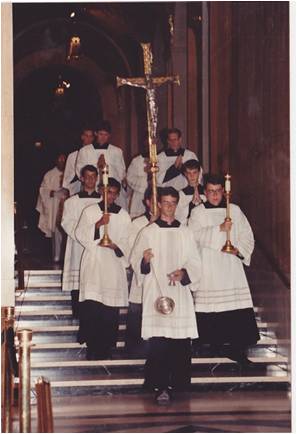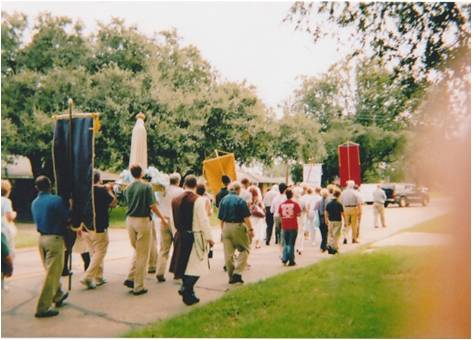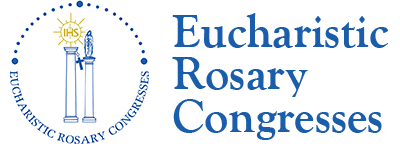The History of the Eucharistic Rosary Congresses
 The History of the Rosary Congresses began in Poland in May 1979, when the Polish people prayed through Mary’s intercession for the coming of Pope John Paul II to his beloved homeland. It has since been attributed as the fulfillment of St. John Bosco’s dream of the Two Pillars (click here to read Dream), bringing the Church into the safe haven of Our Lord in the Blessed Sacrament and Our Lady under the direction of our Holy Father.
The History of the Rosary Congresses began in Poland in May 1979, when the Polish people prayed through Mary’s intercession for the coming of Pope John Paul II to his beloved homeland. It has since been attributed as the fulfillment of St. John Bosco’s dream of the Two Pillars (click here to read Dream), bringing the Church into the safe haven of Our Lord in the Blessed Sacrament and Our Lady under the direction of our Holy Father.
The “Pillars of Victory” are thus clearly made known to us – Jesus in the Eucharist and true devotion to the Blessed Virgin Mary. The Rosary Congress is a gift from Our Lady for the pivotal work of establishing everywhere the Pillars of Victory prophesied by Don Bosco. And thus began the road that led to the very first Rosary Congress, in Poland, in 1979.
How It All Began
In 1978, our Holy Father, Pope John Paul II, requested permission to visit Poland. The government would permit him to enter Poland if he would visit only those places predetermined by the government. The Holy Father desired to visit other places. Permission was not granted; the trip to his homeland seemed to be in jeopardy. 
On December 8, 1978, through a private revelation, Our Lady requested seven days and nights of continuous Rosaries to be said from May 1 – 7, 1979, at the shrine of Our Lady of Czestochowa. The prayers were to be offered for a resolution of the impasse preventing the papal pilgrimage. On the same day (Dec. 8), Our Lady’s request was relayed to Bishop Zbigniew Kraszewski, a member of the Polish episcopate’s Marian Commission. He said, “It is good to pray in front of the Blessed Sacrament. It is good to say the Rosary for the intentions of the Pope. It is good to pray at Jasna Gora. Do it!” The next day, the late Bishop Stefan Barela, Ordinary of Czestochowa and president of the bishops’ Marian Commission was approached. He was pleased with the idea of seven days of prayer and encouraged it. However, he advised that it not be called a congress, for he feared possible repercussions from governmental authorities. “If you do not call it a congress, it will be easier for you to organize,” he said.
The Siege of Jericho
Around The Clock Prayer
A Triumph For Our Lady
The Rosary Congress in the United States
In 1988, one of the original participants of the Rosary Congress in Poland came to  America to bring the gift from Our Lady to us. He found a small group of faithful people on the east coast who grasped the spirit of the congresses and began to organize. The First National Rosary Congress was held in Washington, D.C., in 1988, at the National Shrine of the Immaculate Conception, now a Basilica. Over the next five years the National Rosary Congress drew as many as 500 people who came from all over the country as well as outside of the country, who stayed at Catholic University during the week of prayer and adoration. There were many activities and conferences during those Congresses to encourage and strengthen the faithful, and to educate them in True Devotion to Mary and other practices such as wearing the Brown Scapular, praying the Liturgy of the Hours, and holding candlelight processions.
America to bring the gift from Our Lady to us. He found a small group of faithful people on the east coast who grasped the spirit of the congresses and began to organize. The First National Rosary Congress was held in Washington, D.C., in 1988, at the National Shrine of the Immaculate Conception, now a Basilica. Over the next five years the National Rosary Congress drew as many as 500 people who came from all over the country as well as outside of the country, who stayed at Catholic University during the week of prayer and adoration. There were many activities and conferences during those Congresses to encourage and strengthen the faithful, and to educate them in True Devotion to Mary and other practices such as wearing the Brown Scapular, praying the Liturgy of the Hours, and holding candlelight processions.
 One of the goals of the organizing group was to help participants bring the Rosary Congress back to their own dioceses. That happened in a few instances. In Fort Worth, TX, a woman ran a Rosary Congress in her diocese from 1990-2010. In New Orleans, there has been a Rosary Congress every year since 1990. The Greater New Orleans Area has experienced numerous graces due to their Rosary Congresses. The very last day of their very first Congress in 1990, the largest abortion clinic closed its doors. After the last day of their Rosary Congress in 2016, another abortion clinic closed its doors. In addition, they have had an increase in the number of seminarians in the archdiocese. Imagine the numerous graces our country would receive if many more dioceses held a Eucharistic Rosary Congress.
One of the goals of the organizing group was to help participants bring the Rosary Congress back to their own dioceses. That happened in a few instances. In Fort Worth, TX, a woman ran a Rosary Congress in her diocese from 1990-2010. In New Orleans, there has been a Rosary Congress every year since 1990. The Greater New Orleans Area has experienced numerous graces due to their Rosary Congresses. The very last day of their very first Congress in 1990, the largest abortion clinic closed its doors. After the last day of their Rosary Congress in 2016, another abortion clinic closed its doors. In addition, they have had an increase in the number of seminarians in the archdiocese. Imagine the numerous graces our country would receive if many more dioceses held a Eucharistic Rosary Congress.
Rosary Congress Today
Eighteen Diocesan Rosary Congresses* were planned across the country to celebrate the 100th Anniversary of Our Lady of Fatima, from October 7 – October 13, 2017. This was an effort to make reparation for the great sins committed in our country and by our country. This was an effort to ask God for the grace to rebuild the family and lift the cloud of darkness that covers the hearts and minds of our young people. This was an effort to bring our families, our dioceses, our cities, our states and our country into the safe haven of the Immaculate Heart of Mary.
Fourteen Diocesan Rosary Congresses took place in October 2018, in conjunction with the historic Rosary Coast to Coast event on October 7 around the world. More dioceses signed up in 2019, and the momentum continues to grow. A predominantly lay-lead effort, the Rosary Congress Movement is a grass roots effort that seeks the blessing of the local bishop, and draws in the faithful from all over to supply adoration 24 hours a day for 7 days with the Rosary prayed at the top of every hour followed by silent adoration. Providing the adoration and rosary schedule is the main purpose of the Congress, however, to enrich the community’s gathering together to worship, evangelize, and make reparation, a diocese can add daily Mass, a special evening Mass each day, Eucharistic processions, guided meditations on the mysteries of our Faith, confessions throughout the week, a literature table where people can find good resources for how to pray the rosary, and Consecration of the Family to the Immaculate and Sacred Hearts of Jesus and Mary.
If you wish to begin your own Rosary Congress, go to the Start Your Own section of this website.
Overview
As previously stated, the Rosary Congress is a cenacle of prayer that hastens the triumph of the Immaculate Heart of Mary. This truly spiritual experience is a foretaste of how beautiful the world will be when humanity returns to the love and service of God. It will be that period of peace foretold by Our Lady of Fatima wherein the Eucharistic Heart of Jesus will be the center of our lives and the Holy Spirit will fill our hearts with the fire of His love to renew the face of the earth.
The Cenacle or upper room in which the Eucharist was instituted at the Last Supper was also the scene of the first novena in preparation for the descent of the Holy Spirit. At His Ascension Jesus had asked His disciples to return to Jerusalem and await there the Gift He would send them at Pentecost. So they gathered in the cenacle around the Holy Mother in continuous prayer. Now, Our Lady invites us to gather with her again in cenacles of prayer and fraternity to await the second Pentecost.
In that spirit, a Rosary Congress desires to be nothing but a continuous cenacle. Following the Polish example, much time is spent in Eucharistic adoration while meditating on the central mysteries of our Faith in the prayer of the holy Rosary; conferences help to enlighten and strengthen our Faith; and all is enveloped in a spirit of penance and reparation for our sins and for the sins of humanity in order to call down God’s mercy upon the whole world.
Finally, but far from least in importance, it is to be remembered that every Rosary Congress has the explicit desire and intention to be united with Our Holy Father, and to pray for his protection.
The Power of the Rosary
* A perceptive reader will note that although the name of this organization is Eucharistic Rosary Congresses, many sections of this website refer to Diocesan Rosary Congresses. In 2023, the Board of Directors met to discuss the future of the organization (as we do every year), and while our primary focus is upon fulfilling our mission of expanding Rosary Congresses to every diocese, it's also clear that we could do more to promote the Eucharistic aspects of the Rosary Congress. We therefore elected to change the name to more fully express the purpose of the Rosary Congress: to seek that intimate connection with Our Eucharistic Lord, through Our Lady as Mediatrix of All Graces, through the Holy Rosary. Rather than change the verbiage from the earlier Congresses, we have elected to continue to refer to those events as Diocesan Rosary Congresses.

